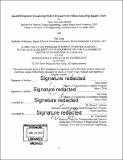Quantifying and visualizing risk in the garment manufacturing supply chain
Author(s)
Braud, Jason Alexander, 1984-; Gong, Siqi
DownloadFull printable version (9.231Mb)
Other Contributors
Massachusetts Institute of Technology. Engineering Systems Division.
Advisor
Bruce C. Arntzen.
Terms of use
Metadata
Show full item recordAbstract
Supply chains are exposed to a variety of risks as they become more complex and geographically diverse. Disruptions due to these risks can be costly. Companies cannot hope to mitigate all of their supply chain risks. In order to focus risk management resources on locations in the supply chain with the most risk, companies need a comprehensive method to quantify all of their significant supply chain risks. We worked with a company in the garment manufacturing industry to map their supply chain for a few representative products. Using input from the company, we equated different risk indices with the probability of loss of a node in their supply chain. The probabilities of loss allowed us to calculate a value-at-risk at each node. Once calculated, the values-at-risk were overlaid on a visual depiction of the company's supply chain network. While previous studies have quantified and visualized risk in companies' supply chains, our research sought to combine different categories of risk in order to give a more comprehensive picture of the risk at each node. We looked at disruption risks due to natural disasters, supplier bankruptcy, and political instability. We found that commercially available indices that quantify different categories of risk can be used to inform supply chain risk management decisions. Moving from these indices to a value-at-risk model of a supply chain is not a wholly quantitative process. Therefore, the strength of the model lies more in the relative quantities of value-at-risk rather than their absolute values. Overlaying these values-at-risk over a visual depiction of their supply chain gave the company a clearer picture of where to focus risk management efforts. Other companies in other industries could apply a similar approach to build an organizational risk management tool.
Description
Thesis: M. Eng. in Logistics, Massachusetts Institute of Technology, Supply Chain Management Program, 2016. Cataloged from PDF version of thesis. Includes bibliographical references (pages 56-57).
Date issued
2016Department
Massachusetts Institute of Technology. Supply Chain Management ProgramPublisher
Massachusetts Institute of Technology
Keywords
Supply Chain Management Program., Engineering Systems Division.